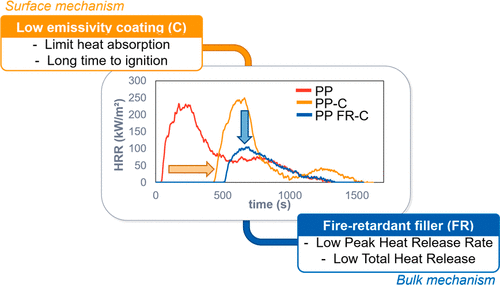当前位置:
X-MOL 学术
›
ACS Appl. Polym. Mater.
›
论文详情
Our official English website, www.x-mol.net, welcomes your feedback! (Note: you will need to create a separate account there.)
Low-Emissivity Metal/Dielectric Coatings as Radiative Barriers for the Fire Protection of Raw and Formulated Polymers
ACS Applied Polymer Materials ( IF 5 ) Pub Date : 2020-06-09 , DOI: 10.1021/acsapm.0c00399 Anne-Lise Davesne 1 , Tsilla Bensabath 1 , Johan Sarazin 1 , Séverine Bellayer 1 , Fabrice Parent 2, 3 , Fabienne Samyn 1 , Maude Jimenez 1 , Frédéric Sanchette 2, 3 , Serge Bourbigot 1
ACS Applied Polymer Materials ( IF 5 ) Pub Date : 2020-06-09 , DOI: 10.1021/acsapm.0c00399 Anne-Lise Davesne 1 , Tsilla Bensabath 1 , Johan Sarazin 1 , Séverine Bellayer 1 , Fabrice Parent 2, 3 , Fabienne Samyn 1 , Maude Jimenez 1 , Frédéric Sanchette 2, 3 , Serge Bourbigot 1
Affiliation

|
Radiative heat transfer dominates in medium- to large-scale fires, with infrared ray absorption causing the rapid ignition of combustible materials. In an attempt to hinder this phenomenon, low-emissivity coatings consisting of an aluminum layer topped by alumina have been deposited on polypropylene (PP) and polyamide 6 (PA6) substrates by pulsed DC magnetron sputtering. Emissivity measurements have confirmed the decrease in the emissivity of both surfaces. The samples were tested with a mass loss cone (MLC) calorimeter at 50 kW/m2 to mimic the radiative thermal constraint of the last stages of a developing fire. The evolution of the temperature was monitored by a thermocouple to confirm the radiative barrier effect. With this setup, it was evidenced that the presence of low-emissivity coatings reduced the heat absorption, effectively increasing the time to ignition of both substrates. Indeed, coated PP ignited after 7 min, whereas a neat PP ignited in 1 min, and PA6 had a time to ignition of as long as 1 h, as opposed to the neat polymer igniting in only 75 s. However, the effect of the coating on flammability parameters such as the peak heat release rate (PkHRR) and the total heat release (THR) was found to be very low. To counterbalance this downside and to take advantage of the reduction of heat absorption, Al/Al2O3 coatings were deposited on PP and PA6 filled with thermally triggered fire-retardant additives, respectively, expandable graphite and a commercial mixture of melamine polyphosphate and aluminum diethylphosphate. Without surface treatment, the presence of the additives caused a shorter time to ignition, but a reduction in the PkHRR of ∼50%. The combination of the Al/Al2O3 coating with flame retardants in the bulk led to both a long time to ignition and a reduction in the PkHRR and the THR under MLC testing.
中文翻译:

低辐射率金属/介电涂层作为辐射屏障,用于原料和配方聚合物的防火
辐射传热在中型到大型火灾中占主导地位,而红外线吸收则导致可燃材料迅速着火。为了阻止这种现象,已经通过脉冲直流磁控溅射在聚丙烯(PP)和聚酰胺6(PA6)基底上沉积了由氧化铝覆盖的铝层组成的低辐射涂层。发射率测量已确认两个表面的发射率均下降。使用质量损失锥(MLC)量热仪以50 kW / m 2的质量测试样品模仿火势蔓延的最后阶段的辐射热约束。用热电偶监测温度的变化,以确认辐射屏蔽效应。通过这种设置,已证明低辐射率涂层的存在降低了热吸收,有效地增加了两个基板的着火时间。实际上,涂层PP在7分钟后点燃,而纯PP在1分钟内点燃,而PA6的点燃时间长达1小时,而纯聚合物在75 s内点燃。然而,发现涂层对可燃性参数例如峰值放热速率(PkHRR)和总放热(THR)的影响非常低。为了抵消这种不利影响并利用减少热量吸收的优势,Al / Al 2 O 3将涂料分别沉积在填充有热触发阻燃添加剂的PP和PA6上,该添加剂分别是可膨胀石墨和三聚氰胺多磷酸酯和磷酸二乙酯铝的商业混合物。未经表面处理,添加剂的存在可缩短点火时间,但PkHRR降低约50%。Al / Al 2 O 3涂层与大量阻燃剂的结合导致长时间着火,并降低了MLC测试下的PkHRR和THR。
更新日期:2020-07-10
中文翻译:

低辐射率金属/介电涂层作为辐射屏障,用于原料和配方聚合物的防火
辐射传热在中型到大型火灾中占主导地位,而红外线吸收则导致可燃材料迅速着火。为了阻止这种现象,已经通过脉冲直流磁控溅射在聚丙烯(PP)和聚酰胺6(PA6)基底上沉积了由氧化铝覆盖的铝层组成的低辐射涂层。发射率测量已确认两个表面的发射率均下降。使用质量损失锥(MLC)量热仪以50 kW / m 2的质量测试样品模仿火势蔓延的最后阶段的辐射热约束。用热电偶监测温度的变化,以确认辐射屏蔽效应。通过这种设置,已证明低辐射率涂层的存在降低了热吸收,有效地增加了两个基板的着火时间。实际上,涂层PP在7分钟后点燃,而纯PP在1分钟内点燃,而PA6的点燃时间长达1小时,而纯聚合物在75 s内点燃。然而,发现涂层对可燃性参数例如峰值放热速率(PkHRR)和总放热(THR)的影响非常低。为了抵消这种不利影响并利用减少热量吸收的优势,Al / Al 2 O 3将涂料分别沉积在填充有热触发阻燃添加剂的PP和PA6上,该添加剂分别是可膨胀石墨和三聚氰胺多磷酸酯和磷酸二乙酯铝的商业混合物。未经表面处理,添加剂的存在可缩短点火时间,但PkHRR降低约50%。Al / Al 2 O 3涂层与大量阻燃剂的结合导致长时间着火,并降低了MLC测试下的PkHRR和THR。



























 京公网安备 11010802027423号
京公网安备 11010802027423号